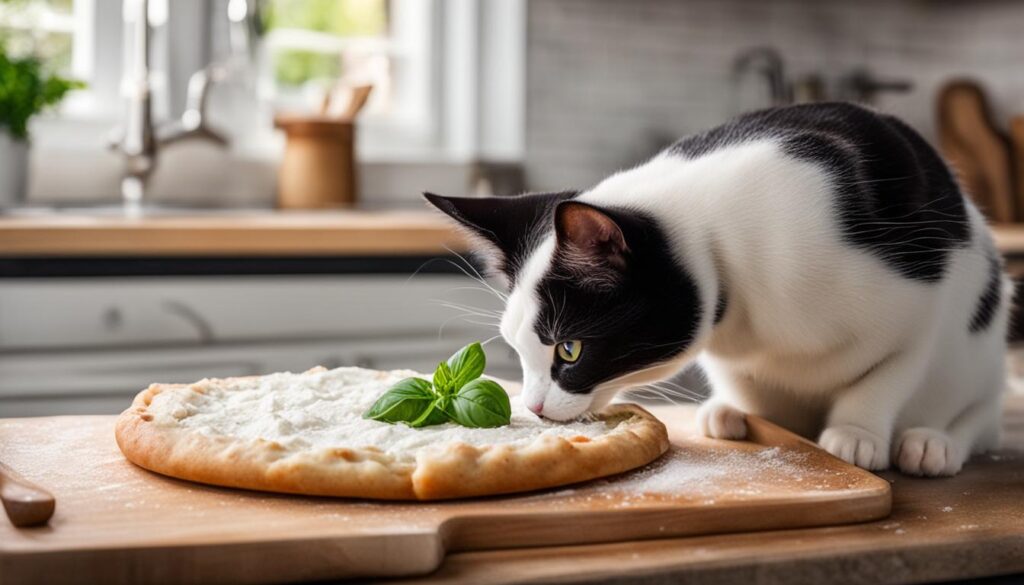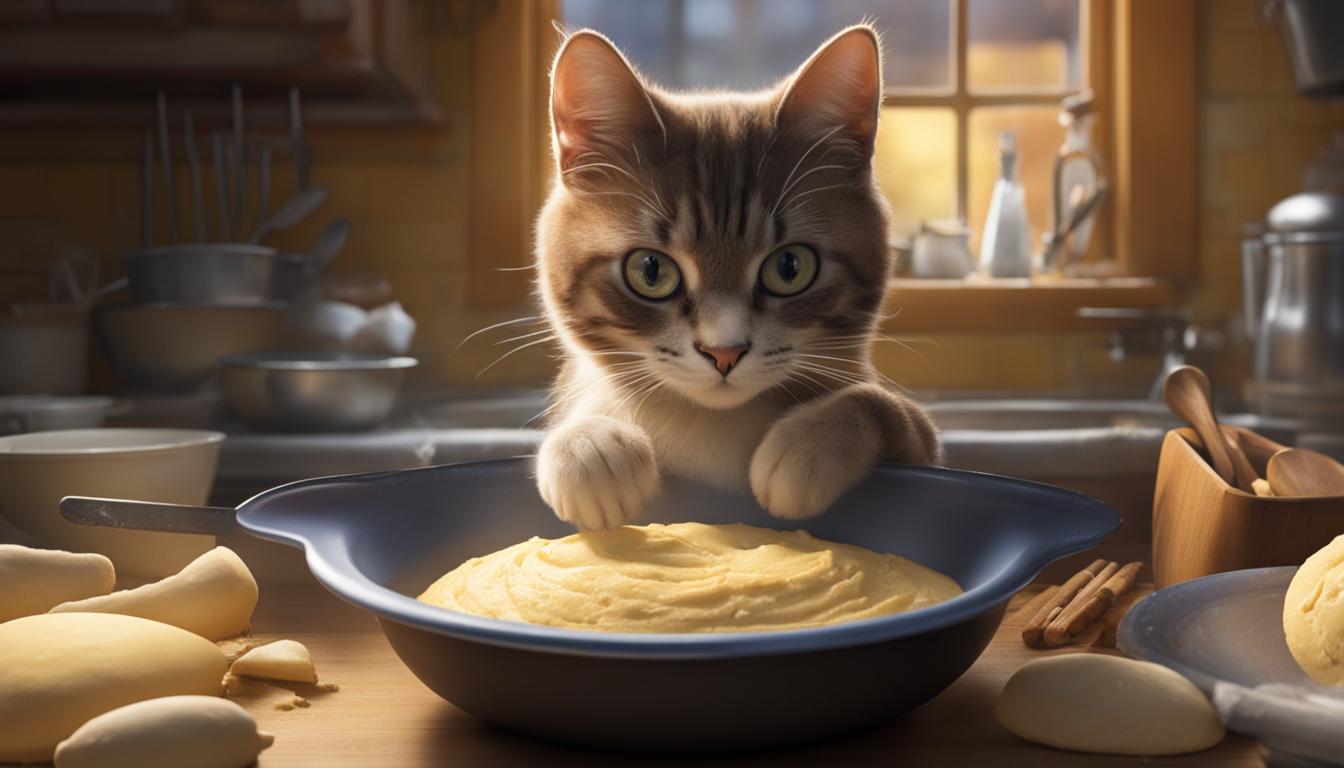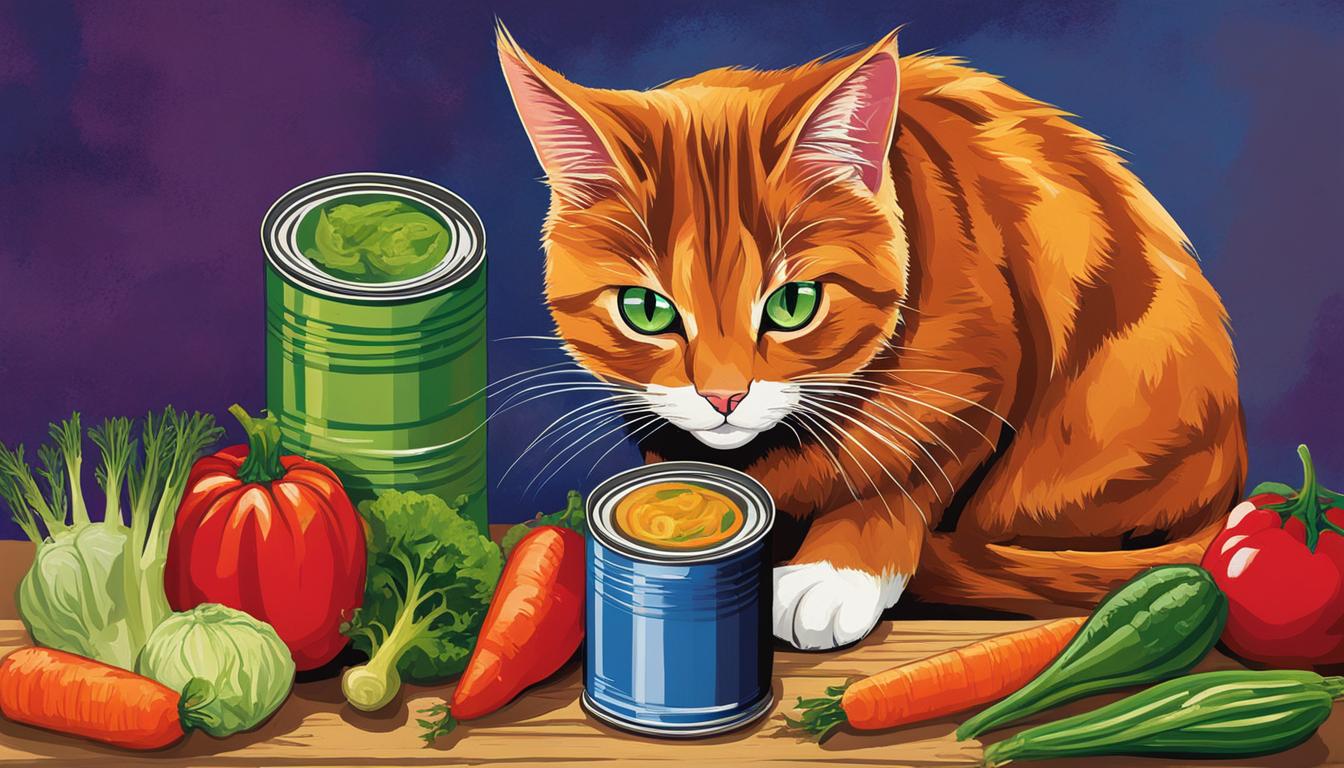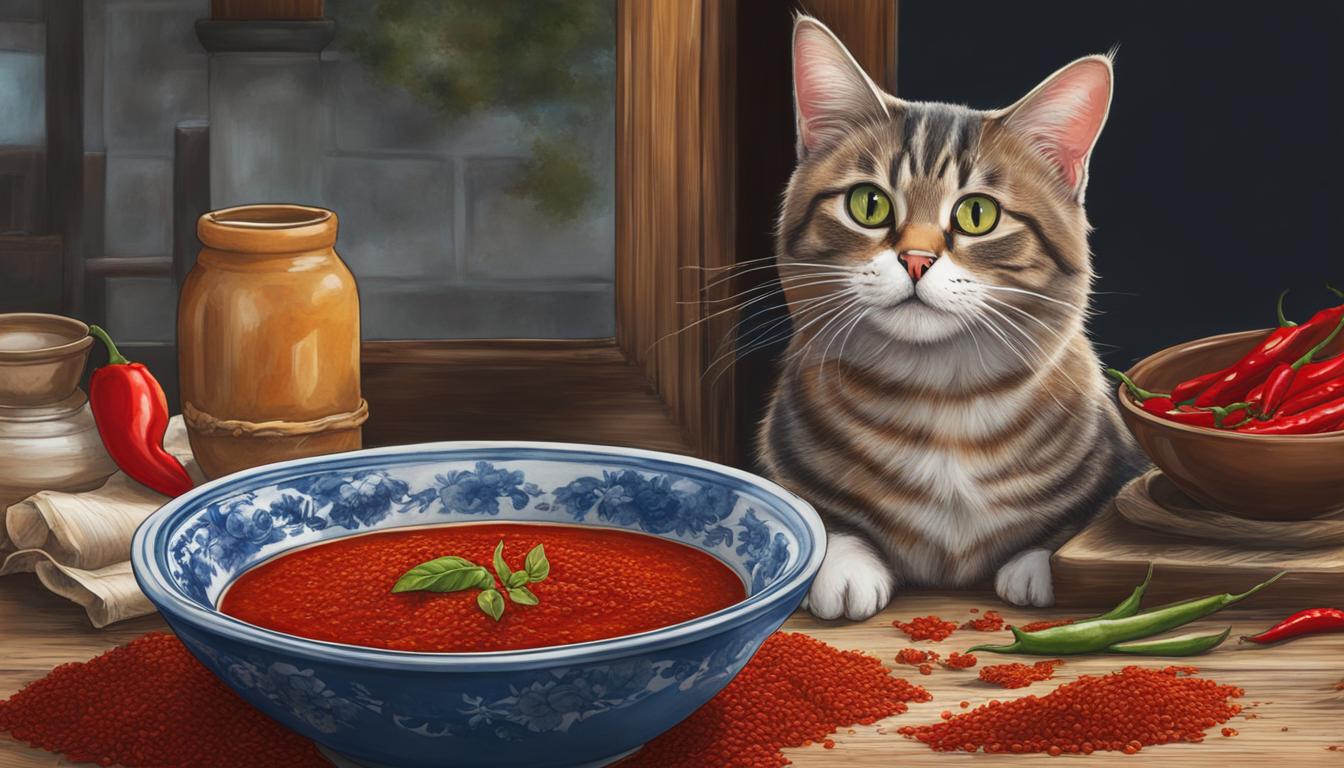Hey there, fellow cat enthusiasts! Today, I want to explore a curious question that many cat owners may have wondered about: Can cats eat raw dough? As it turns out, feeding raw dough to our feline friends can be quite dangerous and pose serious risks to their health. So, let’s dive in and uncover the dangers of yeast dough for cats!
Key Takeaways:
- Raw, uncooked yeast dough is extremely dangerous for cats and dogs.
- The fermentation process in dough produces ethanol and carbon dioxide, leading to alcohol poisoning and gastrointestinal issues in pets.
- Symptoms of dough ingestion include disorientation, bloating, ataxia, and respiratory depression.
- Immediate treatment is necessary, including inducing vomiting or gastric lavage, fluid therapy, and supportive care.
- Keep raw dough out of your cat’s reach to prevent ingestion and potential complications.
The Dangers of Dough Consumption
When it comes to cats and bread dough, the risks are not to be taken lightly. While fully-baked bread is generally safe for pets as an occasional treat, uncooked yeast dough can be extremely harmful if ingested. The fermentation process that occurs in the stomach of cats after consuming raw dough can lead to the production of ethanol and carbon dioxide. This can result in a range of symptoms including disorientation, bloating, ataxia, acidosis, tremors, hypotension, hypothermia, and even respiratory depression.
Ingesting raw dough introduces a significant amount of ethanol into a cat’s system, which can cause alcohol poisoning. It is important to understand that even small amounts of raw dough can be dangerous for cats, and immediate action should be taken if ingestion occurs. Inducing vomiting or performing gastric lavage within an hour of exposure is recommended to remove the toxic substance from the cat’s stomach.
To provide additional context, I have prepared a table highlighting the potential symptoms of dough consumption in cats:
| Symptoms of Dough Ingestion in Cats |
|---|
| Disorientation |
| Bloating |
| Ataxia |
| Acidosis |
| Tremors |
| Hypotension |
| Hypothermia |
| Respiratory depression |
It’s important for cat owners to be vigilant and keep raw dough out of their pet’s reach. During the proofing stage of bread-making, when the dough is allowed to rise, cats may be particularly attracted to the smell and texture. Take precautions such as securely covering dough bowls or keeping them in closed spaces to prevent accidental ingestion. If you suspect that your cat has consumed raw dough, it is crucial to contact a veterinarian immediately for proper assessment and treatment. Remember, the safety and well-being of our furry friends should always be a top priority!
Treatment of Dough Consumption
When it comes to dough consumption, immediate treatment is crucial to minimize the risks associated with yeast dough ingestion in cats. The severity of symptoms can vary depending on the amount consumed, but taking prompt action is always recommended.
If the patient has not yet shown any symptoms, inducing vomiting within the first hour of exposure is ideal. However, it’s important to note that emesis may not always be possible, especially if the cat is already exhibiting signs of distress. In such cases, other treatment options may include gastric lavage, fluid therapy, pressor agents to stabilize blood pressure, and antiemetics to control vomiting.
Supportive care is essential in cases of dough consumption. Most patients recover within 12-24 hours with appropriate care and monitoring. It’s important to note that activated charcoal is not effective in binding to ethanol and should therefore not be used as a treatment option. Severe cases may require hemodialysis, a process where a machine filters the blood to remove toxins and waste products.
| Treatment Options for Dough Consumption | Details |
|---|---|
| Inducing Vomiting | If the cat is not yet symptomatic, vomiting can be induced to remove the ingested dough from the stomach within the first hour. |
| Gastric Lavage | If vomiting is not possible or if the cat is already exhibiting symptoms, gastric lavage involves flushing the stomach with a sterile solution to remove the dough. |
| Fluid Therapy | Fluid therapy is essential to prevent dehydration and support the cat’s overall well-being during recovery. |
| Pressor Agents | Pressor agents may be administered to stabilize the cat’s blood pressure if it drops significantly. |
| Antiemitics | Antiemitics are prescribed to control vomiting and reduce discomfort. |
| Hemodialysis | In severe cases, hemodialysis may be necessary to remove toxins and waste products from the cat’s blood. |
It’s important to consult with a veterinarian for proper assessment and guidance if you suspect that your cat has consumed raw dough. They will be able to provide the best advice and treatment options tailored to your cat’s specific situation.
Cats and Raw Dough: What to Watch For
When it comes to raw dough, cats can be curious creatures. The enticing aroma and soft texture of uncooked dough can be irresistible to our feline friends. Whether it’s homemade pizza dough or bread dough, cats can be drawn to the proofing process, where the dough is left to rise. But as cat owners, we must be aware of the potential risks associated with cats consuming raw dough.
The dangers lie in the fermentation process that occurs in the dough. As the yeast ferments, it produces ethanol and carbon dioxide. If a cat ingests the raw dough, these byproducts can pose serious health risks. Alcohol poisoning is a real concern, as the ethanol can quickly enter the cat’s bloodstream, leading to disorientation, bloating, and even respiratory depression. Gastrointestinal issues are also a possibility, causing discomfort and potential complications.
To prevent any accidents, it’s important to keep raw dough out of reach of cats. Store it securely in a sealed container or cabinet where your furry friend can’t access it. Additionally, avoid leaving raw dough unattended on countertops or other accessible surfaces. Instead, if you’re in the midst of baking and need to step away, make sure to cover or store the dough securely.
If you suspect that your cat has consumed raw dough, it’s crucial to contact your veterinarian immediately for proper assessment and treatment. They can provide guidance on the next steps to take based on the amount of dough ingested and the symptoms your cat is experiencing. Remember, swift action is key when it comes to ensuring your cat’s health and well-being.

The Risks of Homemade Dough for Cats
While it can be tempting to try and make homemade dough specifically for your cat, it’s important to approach this with caution. Cats have unique dietary needs, and homemade dough may not meet these requirements. Additionally, the risks associated with raw dough still apply, regardless of whether it’s made for human consumption or tailored for cats.
Instead of feeding your cat homemade dough, it’s recommended to opt for vet-approved treats specifically formulated for feline nutrition. These treats are designed to provide the necessary balance of nutrients and are a safer alternative to raw dough. Always consult with your veterinarian before introducing any new type of treat into your cat’s diet.
| Type of Dough | Risks for Cats |
|---|---|
| Raw Dough | Potential alcohol poisoning, gastrointestinal issues |
| Baked Bread Dough | No immediate risks, but lacks necessary nutrients for cats |
| Homemade Dough | Same risks as raw dough and may not meet feline dietary needs |
Conclusion
So, can cats have baked bread? Well, while it may not be harmful in small quantities, it’s not the best choice for their overall health. Baked bread lacks the essential nutrients that cats need in their diet. Instead, opt for healthy cat treats that are specifically formulated to meet their nutritional needs.
On the other hand, yeast and cats don’t mix well at all. Raw dough poses a serious danger to our feline friends. The fermentation process in the dough produces ethanol and carbon dioxide, leading to alcohol poisoning and gastrointestinal problems. This can have potentially fatal consequences for cats if not addressed immediately.
During the rise of homemade bread baking, it’s crucial to keep raw dough out of a cat’s reach. Cats are naturally curious creatures and may be attracted to the smell or texture of the dough, making accidental ingestion more likely. If you suspect that your cat has consumed raw dough, don’t hesitate to contact a veterinarian for proper assessment and treatment.
In conclusion, while baked bread may not be a significant risk for cats, it’s best to avoid it due to the lack of essential nutrients. When it comes to raw dough, however, it’s a whole different story. Keep your furry friend safe by keeping that dough out of reach and seeking immediate veterinary care if ingestion occurs.
FAQ
Can cats eat raw dough?
No, cats should never eat raw dough. The fermentation process in the dough can produce ethanol and carbon dioxide, leading to alcohol poisoning and gastrointestinal issues in cats.
What are the risks of cats eating bread dough?
Consuming raw dough can cause symptoms such as disorientation, bloating, ataxia, acidosis, tremors, hypotension, hypothermia, and respiratory depression in cats. Alcohol poisoning can also be fatal for cats.
How is dough consumption in cats treated?
Immediate treatment is necessary if a cat ingests raw dough. This may include inducing vomiting or gastric lavage, fluid therapy, pressor agents, and antiemetics. Severe cases may require hemodialysis.
What should I watch for if my cat has ingested raw dough?
Keep an eye out for symptoms such as disorientation, bloating, ataxia, acidosis, tremors, hypotension, hypothermia, and respiratory depression. If you suspect your cat has consumed raw dough, contact a veterinarian immediately.
Can cats have baked bread?
While cats can occasionally eat baked bread without significant harm, it is not recommended as it lacks the necessary balance of nutrients for a cat’s diet. It is better to offer healthy cat treats as alternatives.





